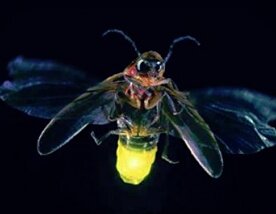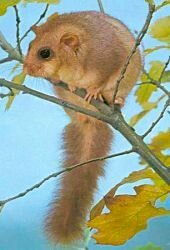|
 |
NATURAL HISTORY
Night time
|
 |
|
|
|
Dusk in May and early June is the time for Fire-flies...the little bright moving lights flitting around like tiny sparkling stars.
Perhaps disappointingly these fascinating and unique creatures are rather plain small flying beetles. . They have fascinated humans for thousands of years and are the subjects of many legends.
Fireflies emit light mostly to attract mates, although they also communicate for other reasons as well, such as to defend territory and warn predators away. In some firefly species, only one sex lights up. In most, however, both sexes glow; often the male will fly, while females will wait in trees, shrubs and grasses to spot an attractive male. If she finds one, she'll signal it with a flash of her own.
|
  
Larger than life-size photos of Fireflies by courtesy of Facebook page 'Facts you Never Knew'
|
|
Do not kill them...they don't bite, they have no pincers, they don't attack, they don't burn you, they don't carry disease, they are not poisonous. But they may be extremely valuable to mankind. The unique chemicals which produce the luminous glow are being used in medical research, particularly cancer research, as they may one day help track the spread of cancer cells from the trackable "light" . For more information see: (BBC News article)
|
|
More photos of firefly beetles     
By courtesy of Wikipedia.org
|
| |
Another night sound of the leafy areas in Agios Georgios is a monotonous note repeated endlessly. This is the sad call of the secretive Scops Owl which spends the day pressed invisibly against a tree trunk. The greek name is 'Yionis' based on its call 'john; john, john' which is said to be plaintively calling for its lost mate.
Have you heard this sad sound before? |

Scops Owl
(photo by kind permission of the World Owl Trust charity
http://www.owls.org/)

|
|
| |
Mammals
|
|
Several mammals have nocturnal life-styles and some of these have been seen around Agios Ggeorgios.
|

|
|
Although unlikely to be seen by visitors, this mostly nocturnal animal is a European Dormouse, reputedly famous for its snoring. Other names are Fat Dormouse and Edible Dormouse. This last name is because it a delicacy in Roman times and was fattened up on walnuts for banquets, not because it is a dish at local Corfu restaurants.
It is a larger species and less colourful than the British version. It can become a pest as it damages crops and trees and sometimes enters house lofts causing damage there.
|
|
|
|
Returning to the hotel one evening we saw a large Stoat in the car headlights. We stopped and watched it for a few moments. Then it bounded to the verge and struggled to get through a link fence before staring at us again. A few moments later it was seen running along the top of the hotel wall. It seemed darker than the one in the photograph so the white chest and underparts stood out beautifully.
|
|
|
|
| |
| |
Several visitors have reported seeing Martensin the Agios Georgios area. The writer had a good, but quite short, side-on sighting of one about 10 metres away sitting quietly on a bank adjoining some rather dense 'maquis' very early one morning. Before I could organise my camera it turned to look at me, then with a couple of bounds disappeared into the dense undergrowth. At about 0.5 metres long it is considerably larger than its cousins the stoat and polecat. It is mostly nocturnal so most often seen at dusk or dawn.
The more common is the Beech Marten. Some people claim to have seen the much less common Pine Marten in the area. The 2 closely related species are difficult to distinguish unless a really good view from the front is obtained, not easy at night. The chest of the Pine Marten is reputedly more creamy than the whiter one of the Beech Marten, but that can also verge on the creamy.
The Beech Marten often prowls around houses and even inhabitants roof spaces and outbuildings whereas the Pine Marten
As one specialist puts it : "if you see it round houses or buildings it is probably a Beech Marten, if you see it in a forest it is probablyly a Pine Marten. Some people claim to have seen the much less common Pine Marten in the area. The 2 closely related species are difficult to distinguish unless a really good view from the front is obtained, not easy at night. The chest of the Pine Marten is reputedly more creamy than the whiter one of the Beech Marten, but that can also verge on the creamy.
|
|
 Marten
Marten
|
|
 Marten
Marten
|
|
|
Watch a short video from Italy of a Beech Marten
(opens pop-up window)
(needs fast Internet connection for best viewing).
|

|

Back to Top
|
|
|
|